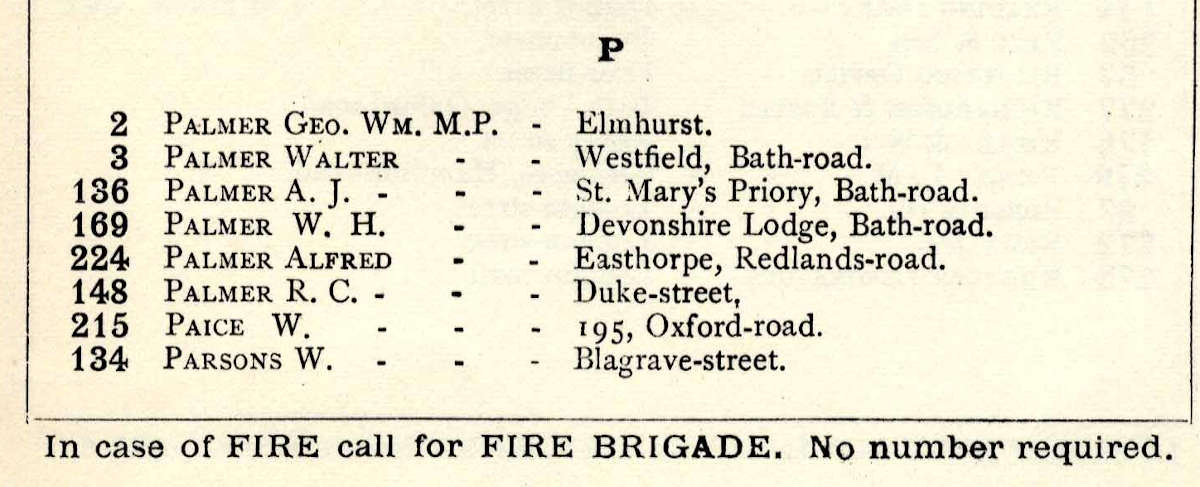September 2022 sees the nation’s Heritage Open Days focus on the theme ‘Astounding Inventions’. One that is hard to imagine life without today, is the telephone. Invented in America in 1876, they began to be widely adopted in the United Kingdom in the 1880s, and in the early 1890s, the National Telephone Company established a service in Berkshire.

The directory they produced for the Thames Valley in 1894 is one of the earliest telephone directories in this country, and we are delighted to share it with you (reference D/EX2859/1). It illuminates how differently the phone network worked 130 years ago – and also some surprising similarities.
The directory explains, ‘Each Subscriber is furnished with a special wire and instrument connected to a Numbered Indicator at the nearest Exchange. The operator identifies Subscribers by their numbers only.’ A form of data protection concern over 100 years ago! The company' s first base was in Reading, but it had additional Exchanges in Marlow, Slough, Windsor, Eton and Staines.
A single exchange linked callers with other phone users in the local area only whereas ‘Trunk lines’ provided communication with other towns. These were circuits connecting telephone switchboards in different areas.
The directory goes on to explain:
‘The Trunk Lines are for use in common by Subscribers and the Public, and Calls are subject to a limit of three minutes. No person can have the use of a Trunk Wire for more than two consecutive periods of three minutes if any one else is waiting for the use of the wire.
The Company have opened Public Telephone Call Rooms in various Towns, where any person, whether a Subscriber or not to the Telephone “Exchange” System, can speak to any firm or person on the Exchange in any Town connected by Trunk Wires.
Nearly all the most important Towns are now telephonically connected.’

There were 8 of these Public Call Rooms in or just outside Reading although not all could send trunk calls. There were located at the NTC’s main offices in the High Street (the end of Broad Street); at the refreshment pavilion in Palmer Park; and the business premises of H Milton, 1 Castle Street; F Attwells, 163 Friar Street; Farrer & Son, 133 London Road; C Bradley, 46 Market Place; C Turner, Prospect Street, Caversham; and J Toop, next to the Three Tuns, Earley. The company also had Telephone Call Rooms in Maidenhead, Windsor, Slough and Marlow, where the public could go to use the telephones for local calls, which cost 1d (one penny) for 3 minutes, with no discount for subscribers.
Trunk calls were discounted for subscribers, who paid 3d for calls within 25 miles, up to 3 shillings for 200 miles. Non-subscribers were charged double. The bill had to be paid within seven days otherwise further calls could be refused by the Operator.
Instructions were given in the directory, and show just how much more complicated the telephones were to operate compared to today’s smartphones. To call another subscriber, you needed to ‘turn the handle, take the receiver off the hook, place it close to your ear and listen for reply. Tell the operator the number of the subscriber you wish to speak to, notice that the number is correctly repeated, and wait with the receiver to your ear until the subscriber asked for replies to the operator’s call. When listening be careful to answer only to your own number.’
To answer a call, ‘Take the receiver off the hook, place it close to your ear and speak. It is of the greatest importance that the bell should be answered IMMEDIATELY it rings; neglect of this frequently causes delay throughout the whole system. Speak about six inches from the transmitter clearly and distinctly but not loudly.’
When a call was finished, it was not enough to hang up the receiver: one needed also to ‘turn the handle to intimate to the Exchange to disconnect you’.
Emergency calls to the Fire Brigade did not need a number – the now familiar 999 was not introduced until 1937.

The telephone service was proudly announced to be 24/7. They did expect things would go wrong every now and then:
‘A “fault” or interruption of service should be reported at once to the Local Manager, in the town in which it arises, and, if possible, on the Company’s form, or by written memorandum. No verbal complaint can be recognised.’
Other modern echoes include the warnings against unauthorised access to equipment:
‘Subscribers are cautioned to refuse to allow strangers to inspect their telephones. The Company’s representatives will always prove their identity when visiting for inspection of apparatus.’

Similarly, sharing your phone subscription was firmly frowned upon:
‘Subscribers are expressly cautioned against permitting the use of their Telephones by Non-Subscribers. Breach of this rule of the Company, which is necessitated by the conditions of the Company’s license from the Postmaster-General involves cancellation of the agreement for the service.’
Later in the 1890s, the trunk lines were transferred to the General Post Office, and in 1912 the National Telephone Company was taken over by the GPO who ran the country’s phone network until 1984.
The directory tells us exactly who locally had a telephone in 1894 – mainly businesses, but also some wealthy individuals. It must have been a really exciting innovation being able to speak to someone miles away for the first time.

